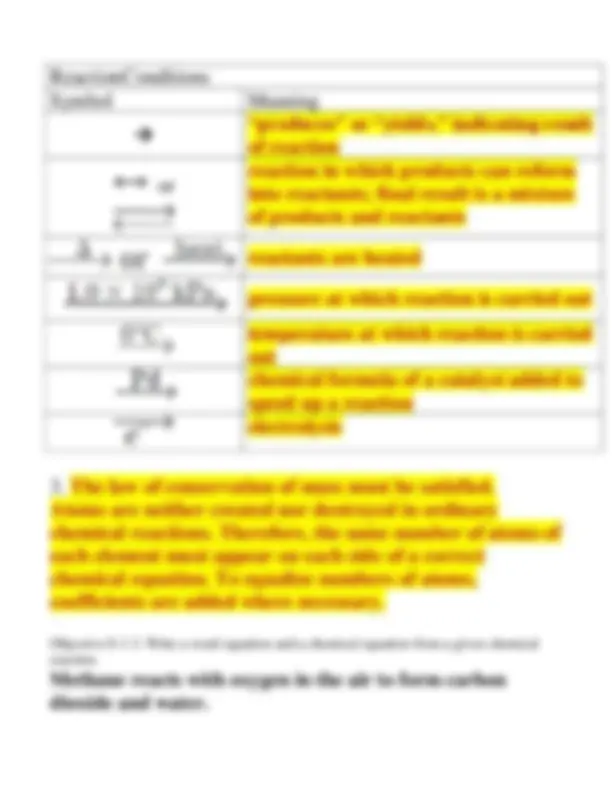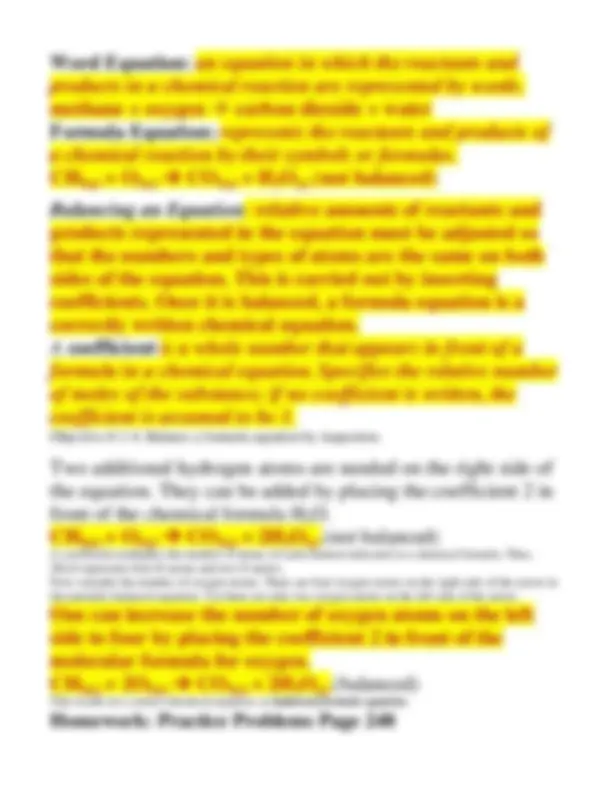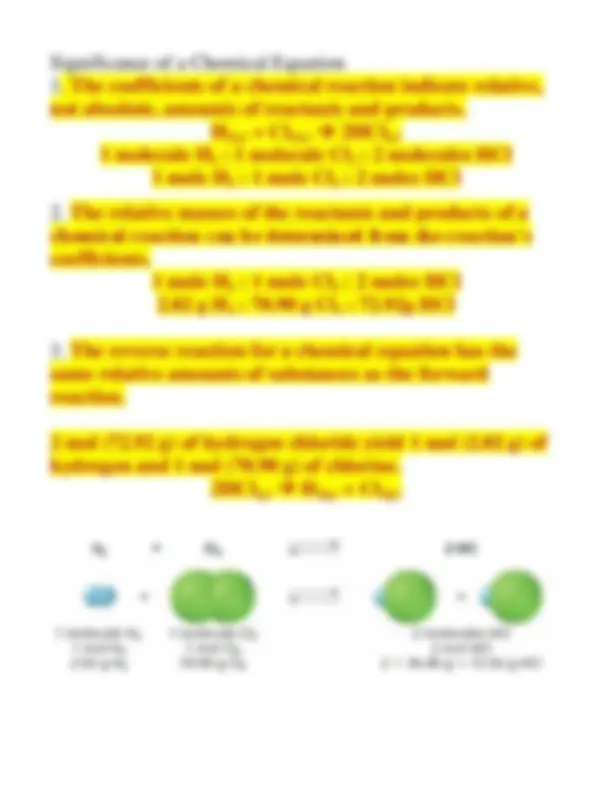





Study with the several resources on Docsity

Earn points by helping other students or get them with a premium plan


Prepare for your exams
Study with the several resources on Docsity

Earn points to download
Earn points by helping other students or get them with a premium plan
Community
Ask the community for help and clear up your study doubts
Discover the best universities in your country according to Docsity users
Free resources
Download our free guides on studying techniques, anxiety management strategies, and thesis advice from Docsity tutors
Observations that suggest a chemical reaction has taken place, including the evolution of heat and light, production of a gas, and formation of a precipitate. It also lists requirements for writing a correctly balanced chemical equation, such as representing known facts, using the correct formulas, and satisfying the law of conservation of mass. examples and guidelines for balancing a chemical equation.
Typology: Study notes
1 / 6

This page cannot be seen from the preview
Don't miss anything!




Chapter 8 Objective 8-1-1 List three observations that suggest that a chemical reaction has taken place. A chemical equation represents, using symbols and formulas, the identities and relative amounts of the reactants and products in a chemical reaction.
To know for certain that a chemical reaction has taken place requires evidence that one or more substances have undergone a change in identity. Absolute proof of such a change can be provided only by chemical analysis of the products. However, certain easily observed changes usually indicate that a chemical reaction has occurred. Possibly a reaction has Occurred when:
releases energy as both heat and light is strong evidence that a chemical reaction has taken place.
two substances are mixed is often evidence of a chemical reaction.
place between substances that are dissolved in liquids. If a solid appears after two solutions are mixed, a reaction has likely occurred. Precipitate: a solid that is produced as a result of a chemical reaction in solution and that separates from the solution.
a chemical reaction.
NOTE: None of these are absolute proof, only strong evidence.
Objective 8-1-2. List three requirements for a correctly written chemical equation.
Symbols Used in Chemical Equations Reactants and Products Symbol Meaning ( s ) or ( cr ) solid or crystal ( l ) liquid ( g ) gas ( aq ) in aqueous solution (dissolved in water) ↓ solid precipitate^ product forms
gaseous^ product^ forms
Word Equation: an equation in which the reactants and products in a chemical reaction are represented by words. methane + oxygen carbon dioxide + water Formula Equation: represents the reactants and products of a chemical reaction by their symbols or formulas. CH4( g ) + O2( g ) CO2( g ) + H 2 O( g ) (not balanced)
Balancing an Equation: relative amounts of reactants and products represented in the equation must be adjusted so that the numbers and types of atoms are the same on both sides of the equation. This is carried out by inserting coefficients. Once it is balanced, a formula equation is a correctly written chemical equation. A coefficient is a whole number that appears in front of a formula in a chemical equation. Specifies the relative number of moles of the substance; if no coefficient is written, the coefficient is assumed to be 1. Objective 8-1-4. Balance a formula equation by inspection.
Two additional hydrogen atoms are needed on the right side of the equation. They can be added by placing the coefficient 2 in front of the chemical formula H 2 O. CH4( g ) + O2( g ) CO2( g ) + 2 H 2 O( g ) (not balanced) A coefficient multiplies the number of atoms of each element indicated in a chemical formula. Thus, 2H 2 O represents four H atoms and two O atoms. Now consider the number of oxygen atoms. There are four oxygen atoms on the right side of the arrow in the partially balanced equation. Yet there are only two oxygen atoms on the left side of the arrow. One can increase the number of oxygen atoms on the left side to four by placing the coefficient 2 in front of the molecular formula for oxygen. CH4( g ) + 2O2( g ) CO2( g ) + 2H 2 O( g ) (balanced) This results in a correct chemical equation, or balanced formula equation. Homework: Practice Problems Page 248
Significance of a Chemical Equation
The coefficients of a chemical reaction indicate relative, not absolute, amounts of reactants and products. H2( g ) + Cl2( g ) 2HCl( g ) 1 molecule H 2 : 1 molecule Cl 2 : 2 molecules HCl 1 mole H 2 : 1 mole Cl 2 : 2 moles HCl
The relative masses of the reactants and products of a chemical reaction can be determined from the reaction’s coefficients. 1 mole H 2 : 1 mole Cl 2 : 2 moles HCl 2.02 g H 2 : 70.90 g Cl 2 : 72.92g HCl
The reverse reaction for a chemical equation has the same relative amounts of substances as the forward reaction.
2 mol (72.92 g) of hydrogen chloride yield 1 mol (2.02 g) of hydrogen and 1 mol (70.90 g) of chlorine. 2HCl( g ) H2( g ) + Cl2( g )